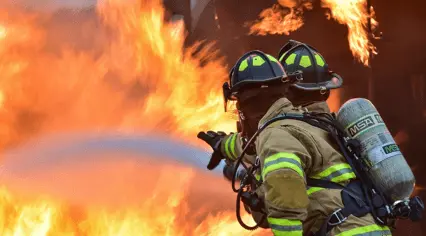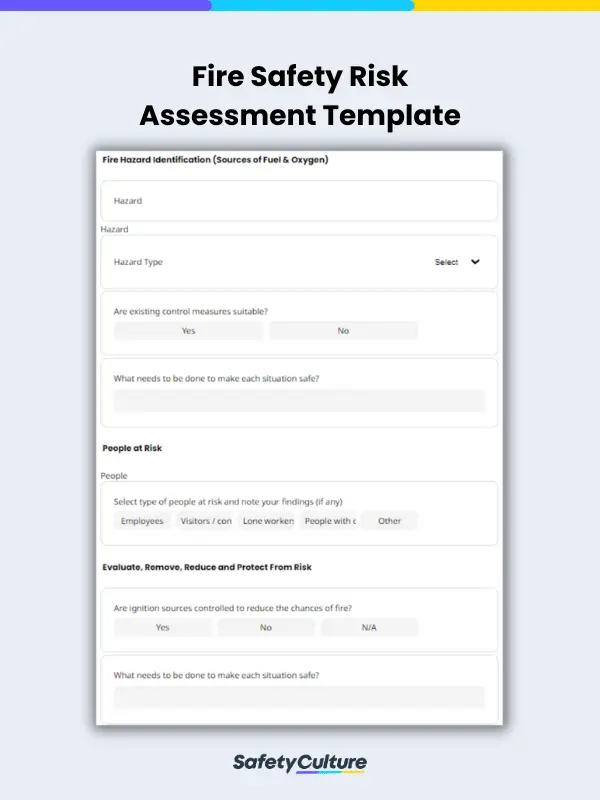What is a Fire Risk Assessment Template?
A fire risk assessment template is a documentation tool used by trained safety officials to identify fire hazards and risks on any site. It assists safety officials as they do a visual check on the site and investigates various areas where fire incidents are more likely to occur.
What to Include in a Fire Risk Assessment Template?
A fire risk assessment template usually comprises the following:
- Information about the site or establishment
- List of identified fire hazards on the premises
- The people at risk
- Schedule for the next review
- Validation of the report through sign-off of the assigned safety official.
Fire risk assessment records should be kept up to date so that precautionary measures are adequate at all times. Failure to comply can result in fines, criminal charges, irreparable damage to business assets, or worse, cost lives.
What is a Fire Risk Assessment?
A fire risk assessment is an evaluation of identified fire hazards and fire protection measures. It also includes planning for the safety of people at risk. Ideally, employers, site managers, and safety officers work together to create effective fire safety plans based on fire risk assessments.
Why Conduct a Fire Risk Assessment?
Aside from it being a legal requirement, conducting a fire risk assessment helps reduce the chances of a fire occurring. Fires not only result in property loss, but can also negatively impact business reputation and weaken the trust clients have in the capability and priority of the business to keep people safe from harm.
In contrast, conducting a fire risk assessment signals to clients that the business is proactive when it comes to fire prevention and fire safety. Conducting regular fire risk assessments also helps strengthen the confidence of potential investors or partners, as it shows that the business is reliable and aware of risks.
How to Conduct Fire Risk Assessment with a Checklist: A Step-by-Step Guide
To easily conduct a fire risk assessment, we’ll walk you through the five steps provided by the County Durham & Darlington Fire & Rescue Service using a fire risk assessment checklist. These steps include:
- Identify any fire hazards
- Determine people at risk
- Evaluate, remove, reduce, and protect people from risk
- Record, plan, inform, instruct, and train
- Review fire risk assessment
Step 1: Identify Fire Hazards
Observe and determine the type of fire hazard. A fire usually starts when heat comes into contact with anything that burns. The three things you need to look for in identifying fire hazards are sources of ignition, fuel, and oxygen. Take measures to avoid these three coming together to reduce the chances of a fire occurring.
Different Types of Fire Hazards
Fire hazards are grouped according to the activity in which they manifest. Activities that are highly likely to cause fire are known as different types of fire hazards.
- Heating water or other substances – This type of fire hazard becomes a greater threat when substances are heated alongside or close to combustible materials such as wood. This type of fire hazard usually results in Class A fires, unless electrical equipment, metals, or chemicals are involved. You can use water or a foam fire extinguisher for Class A fires.
- Handling chemicals or explosives – This type of fire hazard involves flammable liquids, including alcohol, oil, paint, and gasoline, as well as pressurized gases. This type of fire hazard results in Class B fires. Use a foam, carbon dioxide, or powder fire extinguisher for Class B fires. Do not use water for extinguishing Class B fires.
- Using electrical equipment – This type of fire hazard involves circuit breakers, appliances, transformers, wiring, electrical cords, junction boxes, and motors. This type of fire hazard results in Class C fires. Use a carbon dioxide or dry powder fire extinguisher for Class C fires. Do not use water or a foam fire extinguisher for Class C fires.
- Metalworking – This type of fire hazard is commonly found in auto mechanic shops and industrial facilities. Examples of metals known to ignite easily are potassium and sodium. This type of fire hazard results in Class D fires. Use only a dry powder extinguisher for Class D fires. Do not use water or a foam fire extinguisher for Class D fires.
Example:
| Type of Hazard | Flammable Material (gases, liquids, paints, thinners, glues) |
| Are existing control measures suitable? | Yes |
| If yes, elaborate | Flammable materials are stored and labelled properly |
Step 2: Determine People At Risk
Identify people at risk and where they are likely to be found around the premises. This step may require evaluating people with disabilities to discuss individual needs. These people could be:
- employees;
- visitors/contractors;
- people with disabilities, elderly customers, or parents with children; and
- other persons in the immediate vicinity of the premises.
Example:
| Type of Hazard | Flammable Material (gases, liquids, paints, thinners, glues) |
| Are existing control measures suitable? | Yes |
| If yes, elaborate | Flammable materials are stored and labelled properly |
| People at risk | Employees Visitors / contractors Lone workers, e.g. cleaners, security staff People with disabilities |
Step 3: Evaluate, Remove, Reduce, and Protect People from Risk
Using the information gathered from steps 1 and 2, begin evaluating the management of the premises to identify situations and any acts or omissions that may present a fire risk. It is also essential to evaluate fire escapes and other fire precautions to ensure that they are up to date or adequate. Once you’ve evaluated the risks, remove or reduce the hazards you’ve identified by recommending actions and preventive measures.
Example questions for evaluating:
- Are ignition sources controlled to reduce the chances of fire?
- Are combustible materials kept away from ignition sources?
- Are all windows and openings closed last thing at night?
- Is your fire alarm system adequate for your premises?
- Will everybody be warned if the fire alarm operates?
- Are all fire exits easily identified by the correct signs?
- Are escape routes free from obstruction and storage?
Step 4: Record, Plan, Inform, Instruct, and Train
This step involves documenting all the significant findings and actions you’ve taken or will take when you conduct the fire risk assessment. Significant findings refer to fire hazards, actions taken, or preventive measures put in place.
Having a good recordkeeping program for your fire risk assessments is good practice and will be helpful to management and safety officers in case of fire incidents. This step also involves giving staff and employers clear and relevant information and appropriate instructions on fire safety arrangements.
Step 5: Review Fire Risk Assessment
Review your current assessment to determine if fire safety systems implemented are effectively controlling fire hazards and risks in the premises. If, during your review, you find that your fire risk assessment is no longer suitable for your premises and the type of work done onsite, revise it accordingly.
Fire Risk Assessment Example
To get a better visualization of what a completed fire risk assessment should look like, preview this sample report:
FAQs About Fire Risk Assessments
According to Section 9 of the Regulatory Reform, the responsible person (i.e. the employer/business owner, site manager, or safety officer) must make a suitable and sufficient assessment of the risks to which relevant persons are exposed. The purpose of fire risk assessment is to identify the general fire precautions that employers and site managers must take to comply with the requirements of the Regulatory Reform.
Although regular fire risk assessments are recommended to ensure fire safety protocols are kept up to date, there is no law that specifies a specific time frame for how often one should be conducted. In the UK, the Local Government Association (LGA) provides guidance on fire safety for purpose-built flats or residential buildings. Its recommendations on the frequency of fire risk assessments can be used as a good rule of thumb for how often fire risk assessments should be conducted on worksites.
Depending on a site’s level of risk or how hazardous the nature of work is, the responsible person can provide recommendations within the fire risk assessment itself on the frequency of its review. Fortunately, reviews can be done more frequently since they take less time than a new or first-time fire risk assessment. There are certain situations, however, when the responsible person is required to review a fire risk assessment, namely:
- When there’s reason to think that the assessment is no longer valid
- When there have been significant changes since the assessment was conducted
The LGA guidance states that low-rise blocks of up to three floors above ground should have fire risk assessments reviewed every two years and redone every four years. Higher-rise blocks or those that are more than three floors high should have assessments reviewed every year and redone every three years.



